Happy Navratri, 2025!
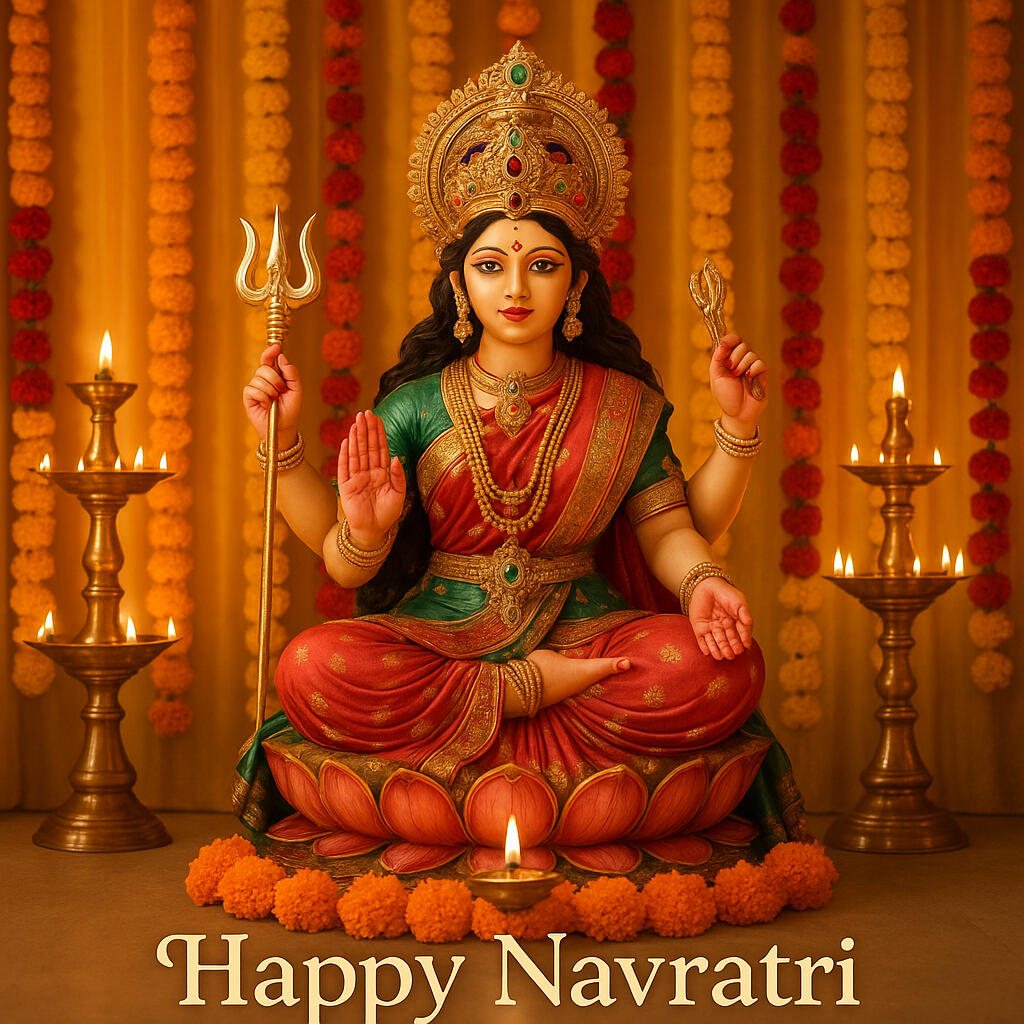
Disclaimer: The thoughts shared below are my personal reflections on Navratri and the Goddess. They are not drawn from scriptures and should not be considered factual. Please explore and do your own research.Navratri, to me, is a celebration of the Devi that lives within each woman. It is a reminder of our motherhood, strength, courage, sacrifice, resilience, and grace.While we honor different forms of Goddess Durga across the nine days, I see these forms as symbols of the stages and lessons in a woman’s life. The names of the goddesses, their qualities, and the three phases of Tamas, Rajas, and Sattva are referenced from traditional sources, but my interpretation of how they mirror our modern lives as women is entirely my own.The word Navratri (Nav = 9, Rathri = nights) can be viewed as three stages of a woman’s journey:🌑 Tamas — Guided by Goddess Durga
The Phase of Growth
A time of innocence, joy, fierce spirit, and expansion.
(Modern science relates this to infancy, childhood, and early growth.)🔥 Rajas — Guided by Goddess Lakshmi
The Phase of Stability
A time of passion, energy, and building stability in life.
(Modern science relates this to adolescence and early adulthood.)✨ Sattva — Guided by Goddess Saraswathi
The Phase of Transformation
A time of wisdom, reflection, and preparation for the cycle to renew.
(Modern science relates this to mid-life, later years, and eventually death.)Our ancestors often taught through stories, and Navratri is one such story — a story of the Goddess, her phases, and her power. Through her journey, we celebrate the Devi within every woman: the eternal source of life, energy, and balance that sustains the world.
Day - 1
Day 1 - Ma Shailaputri
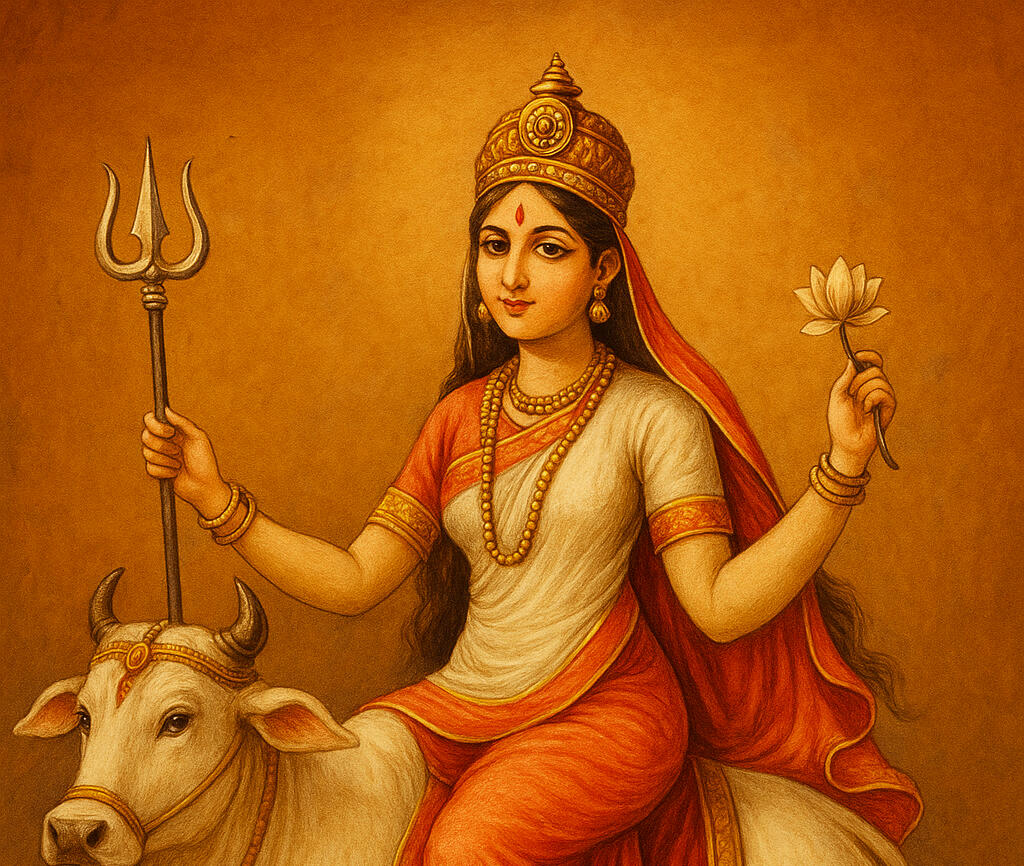
Navratri has always been deeply personal for me. Each goddess feels less like a distant deity and more like a mirror of my own journey as a woman.On the first day, we welcome Ma Shailaputri; the daughter of the mountain king, reborn as the symbol of fresh beginnings. Her story, to me, is not just about mythology, but about the eternal truth of starting again.There was a time in my own life when I felt like everything I had built had crumbled, moments of deep loss, pain, and endings that felt unfair. But much like Shailaputri, I found myself reborn through those fires — stronger, clearer, and ready to step into a new chapter.Seated on her white cow, holding the trident and lotus, she reminds me of the innocence and cheer of childhood — a phase I see not only in my daughter’s life but also in my own early years as a curious, fearless girl who found her voice through public speaking at just 16. That spark of courage was Shailaputri within me.For me, Day 1 is about honoring the little girl inside me — the child full of laughter, curiosity, and untamed strength. It’s also about honoring the mother in me, the one who nurtures and protects.As Navratri begins, Shailaputri whispers: “Every ending is a rebirth. Every fall is a chance to rise again.”And so, I step into these nine days with gratitude — celebrating the Devi within me, within my daughters, and within every woman whose story is still unfolding.
I invite each of you to pause in the middle of life’s constant hustle and take a moment to reflect today.
🌺 What could you unlearn?
🌺 Who or what will support your own journey of rebirth?
And through it all, may you never lose that childlike curiosity and laughter — because that spirit is the Shailaputri within you, guiding your path forward.Here’s to every Shailaputri rising within us.
Day 2 - Ma Brahmacharini
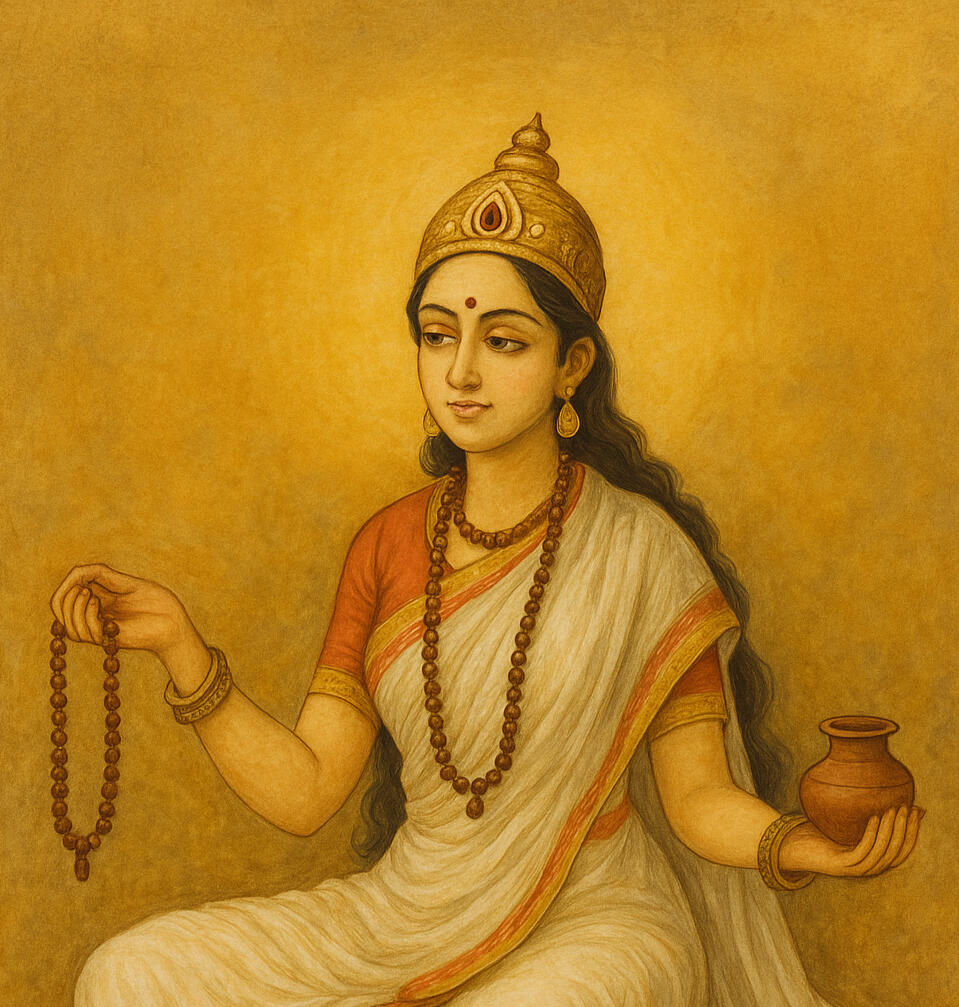
Brahmacharini, the second form of Devi, represents penance, simplicity and inner strength. She is shown walking barefoot, holding a rosary in one hand and Kamandal in the other, a symbol of patience, discipline (tapas) and spiritual pursuit.Her story reminds me that even the Goddess herself had to undergo years of intense discipline and focus, surviving only on leaves and water, to prepare herself for her union with the lord Shiva. To me, this speaks of the resilience we cultivate in our own girlhood. This is the phase where innocence begins to meet curiosity, when our bodies, minds, and desires awaken, but the world doesn't always give us answers.When I reflect back on this phase in my own life, I see the young girl in me who was restless and curious, but I was also learning discipline through struggle. At 16, when I first stumbled into a career of teaching kids public speaking to cater to my own family's financial struggles, I didn't realize I was stepping into my own discipline (tapas). I was unprepared, nervous, and yet something inside me said, "Keep Trying". That inner voice, that quiet discipline, was my Brahmacharini.As a mother now who just dropped off her daughter in college, I now see this phase mirrored in my own daughter. She is full of questions, facing her own inner battles of new college, new friends, and a life she is not used to, all pulled between distractions and discipline. And I realize how important it is to guide her, not with control, but by teaching her how to pause, reflect, and go inward and "keep trying".The lesson of Brahmacharini to me is this: the answers are not out there; they are all within us. But to find them, we must first unlearn the noise of the world through discipline. We must unlearn the rush to compare, the pressure to be perfect, and the distractions that keep us from listening to our own stillness.On this second day of Navratri, I bow to Ma Brahmacharini and to all the young girls out there! Each one of you and each one of us is learning to sit quietly until the answers rise from within and the disciple to keep trying never ends!
Day 3 - Ma Chandraghant
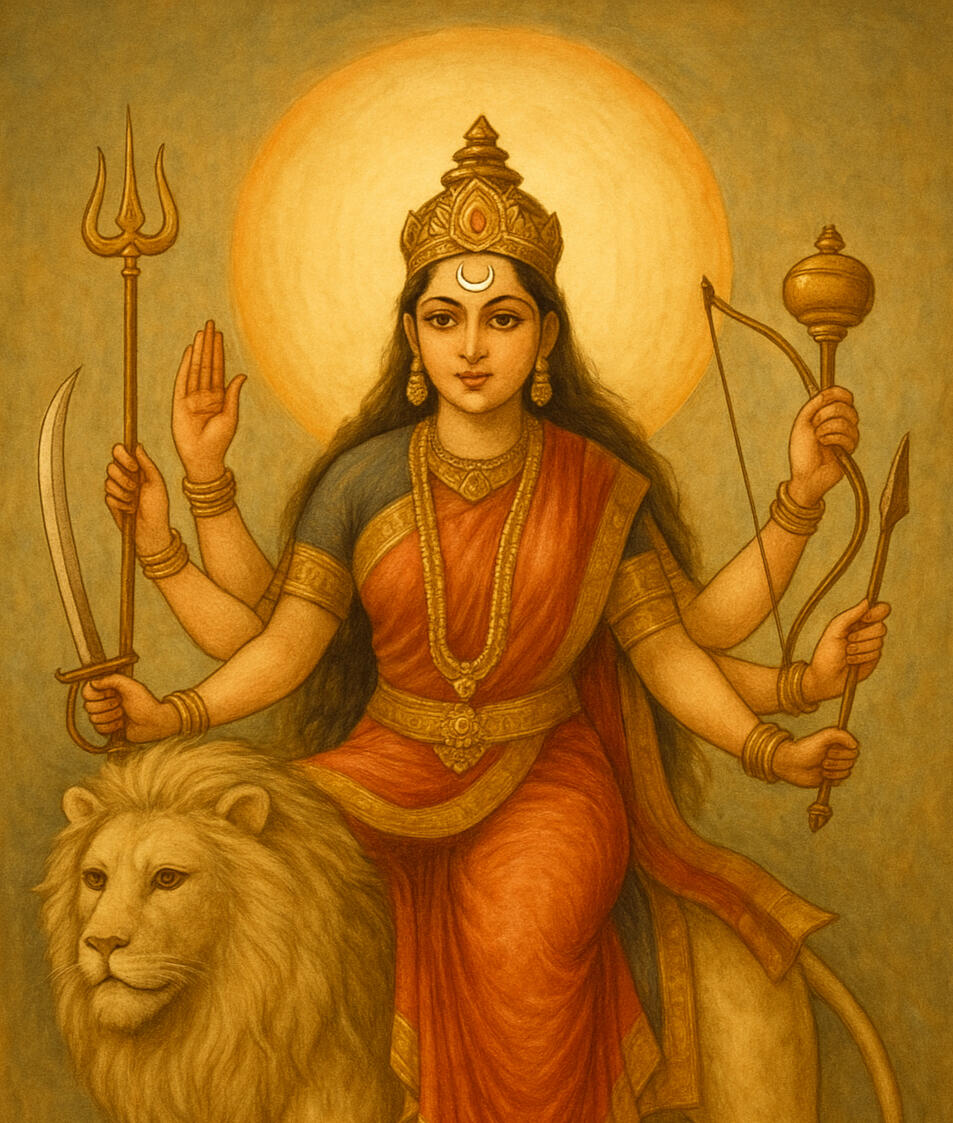
Today, we honor Ma Chandraghanta — the goddess whose name is a fusion of Chandra (Moon) and Ghanta (bell). The symbol on her forehead is depicted as a moon shaped like a bell.Day 3 marks the close of the Tamas phase — the growing years. It is that threshold where innocence begins to meet reality, where we must step out of our cocoon and face the world.For me, Chandraghanta represents those pivotal moments in my life when courage was no longer optional — when I had to step forward and keep going, even when my heart was trembling and I desperately wanted to pause. I remember the time I first left behind the comfort of my home, my sister, and everything that was family to me in India, to build a new life here in the US. The excitement was real, but so were the fears.I was afraid of not being able to fit into this new world, where everything around me — including the language and culture of the man I had married (my husband is from Hyderabad, I am from Bangalore; I speak Tamil, he speaks Telugu) — felt unfamiliar. And beyond that, I faced the uncertainty of the country I was moving into. On top of it all, I was leaving behind the peak of my career in India, where I had been heading South India as the Learning and Development Leader for one of the largest financial institutions in the country. The challenges rang loud in my ears, but the moon reminded me to carry calmness within the noise.This phase, which mirrors early adulthood, is where bravery becomes our companion. It is the time when we learn that facing the unknown does not mean the absence of fear — it means choosing to move forward despite it.Chandraghanta also whispers the wisdom of unlearning fear: fear of judgment, fear of “what if,” fear of failure. These fears are the loud bells that can drown out our inner voice. But when we lean into trusting ourselves, we hear the subtle rhythm of courage that has always been quietly beating within us.On Day 3, I honor Ma Chandraghanta in me. I honor every young woman who dared to walk into new rooms, new countries, and new roles, even when she wasn’t sure she belonged. And I honor the Chandraghanta in every woman who continues to rise bravely, carrying both the calmness of the moon and the strength of the bell.✨ Turn inward today and ask yourself:* What fear is ringing loudly in your life right now?
* How can you unlearn its grip and step forward with courage?
* What “bell” in your life can you turn from noise into strength?Happy Navratri to all of you!
Day 4 - Ma Kushmanda
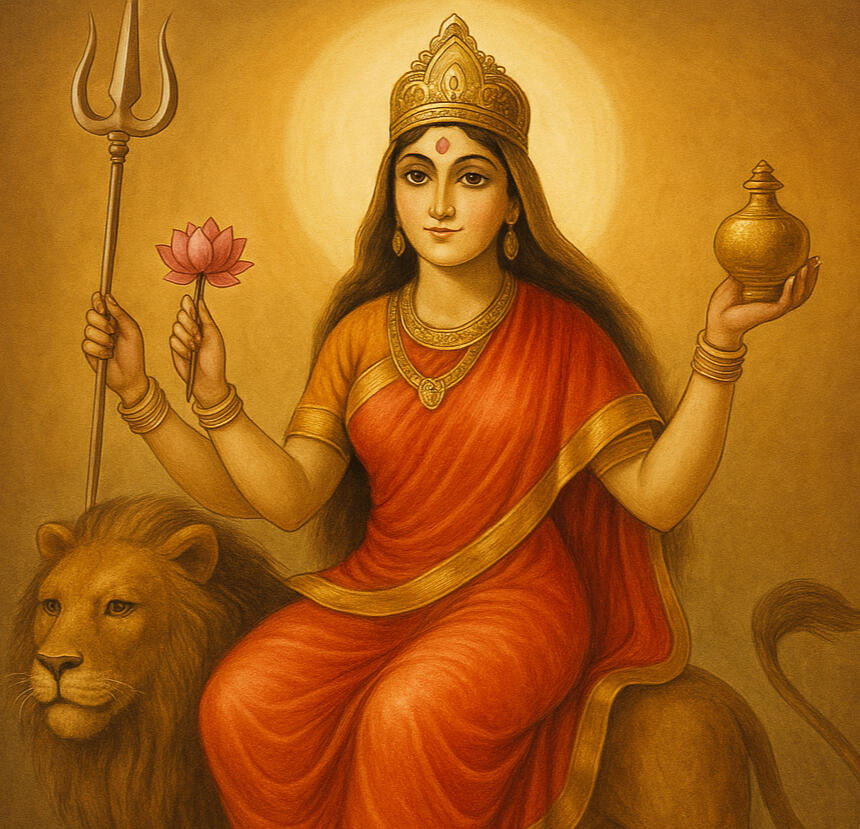
On this fourth day of Navratri, we celebrate Ma Kushmanda, the goddess who created the universe herself. When there was nothing but darkness, it is said that she smiled — and from that smile, light spread across the void. In that moment, the cosmic egg was formed, and creation began.Her very name holds her essence: Ku (little), Ushma (warmth/energy), and Anda (cosmic egg). She is the radiant mother whose warmth gave birth to all life.Day 4 marks the transition from the Tamas (growth) phase to the Rajas (energy and stability) phase. This is the stage of early adulthood, when innocence gives way to passion, and when we step into the responsibility of shaping our worlds — building our own universe through our smile and warmth.For me, Ma Kushmanda represents that turning point when I began creating my own universe. When I first dared to step into leadership roles, or when I took the leap of faith to trust one person — my newlywed husband — and moved to a new country without fully knowing him or his family, while both our families had not yet accepted our relationship. If things had failed, I would have been on my own — without family or friends to guide me, in a country where I was not even legally independent. The friendships I chose, the career I rebuilt, the family I created — each decision was a seed. And with every smile, every risk, and every act of trust, I was creating my own cosmos.Ma Kushmanda’s story also brings me back to one of the darkest seasons of my life — a time when I went through a life-altering surgery. That painful phase made me doubt, many times, whether I had the strength to rebuild. I wondered if I would ever smile again, or spread warmth. In those moments, I felt powerless. A health situation I hadn’t asked for, a challenge I did nothing to deserve — it shook me deeply. And yet, like Ma Kushmanda, I discovered that even the smallest smile could spark light. Even in broken, powerless moments, I carried within me the power to create.Ma Kushmanda taught me to unlearn powerlessness. She showed me that creation does not require perfection — it requires energy, intention, and trust. Every smile in those powerless, dark moments carries the power to birth new worlds.Reflection for Today* What universe have you created around yourself?
* What feeling of powerlessness can you unlearn today?
* How can you use your own light to bring energy and joy to others?Happy Navratri
Day 5 - Ma Skandamata
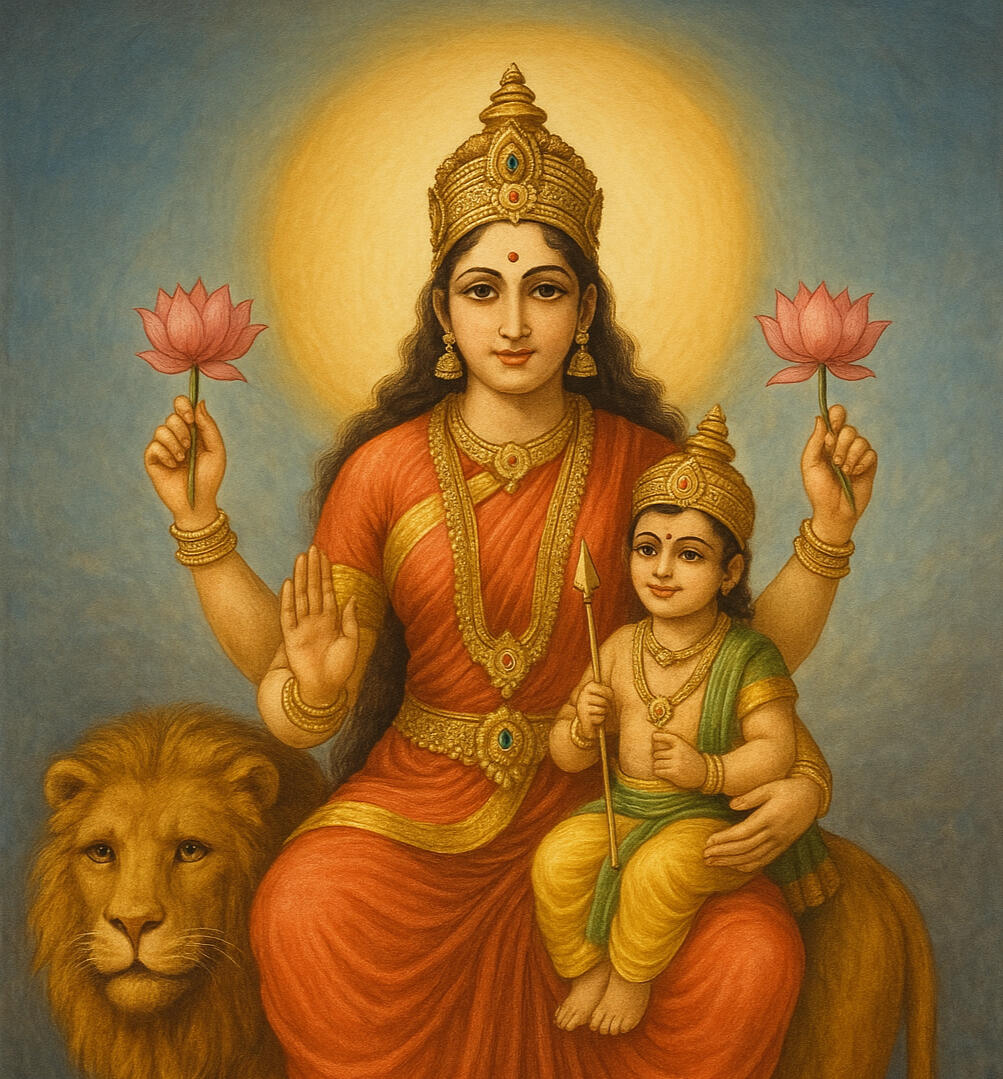
On this fifth day of Navratri, we honor Ma Skandamata — the mother of Skanda (Lord Kartikeya), commander of the gods’ armies. She is depicted seated on a lion, holding her son Skanda in her lap, with two of her four hands carrying lotus flowers and the others supporting her child.Isn’t this who we all are as mothers? A lioness in mind, fierce in our protection, and a lotus at heart, gentle and nurturing when it comes to our children. Ma Skandamata reflects both the strength of a lion to defend and the purity of a lotus, which rises from murky waters to bloom radiant, becoming a role model for her child.Ma Skandamata reminds us of the boundless, unconditional love of motherhood. Her form shows us that true strength is not found in conquest but in compassion. She embodies a love without limits, conditions, or boundaries.For me, this day reflects the phase of my life when I stepped into motherhood. The moment I first held my daughter in my arms, I realized that no matter what I had achieved professionally, nothing prepared me for the sheer vulnerability and limitless love of being a mother. Beyond the overwhelming love, I also encountered fears I never knew existed. I checked every few minutes to make sure she was breathing. I touched her tiny hands and legs over and over again, almost unable to believe she was real. I would panic in the middle of the night, fearing that I was doing something wrong in the way I cared for her. I worried about feeding her, about dropping her, about whether she would grow healthy, speak, see, hear, and walk. Motherhood forced me to surrender to love — a love that both protects fiercely and liberates fully.But Skandamata is not only the goddess of biological mothers; she reminds us of the motherhood within each of us. She symbolizes the capacity to love, nurture, and show compassion that all women hold, whether they have children or not. I see her in myself, not only as a mother to my two beautiful daughters but also as a mentor to students I’ve loved and protected, as a coach guiding leaders, and as a leader who has always had my team’s back.Her greatest teaching to me has been to unlearn conditional love. We so often place expectations on our love — on our children, our partners, or even ourselves. But Ma Skandamata teaches that love is most powerful when it simply is. Love without demands. Love that strengthens rather than binds. That is the love of motherhood.Reflection for Today:
* Where in your life can you practice unconditional love?
* What expectations can you unlearn in the way you love others — or yourself?
* How does the motherhood within you show up beyond family?Happy Navratri
Day 6 – Ma Katyayini
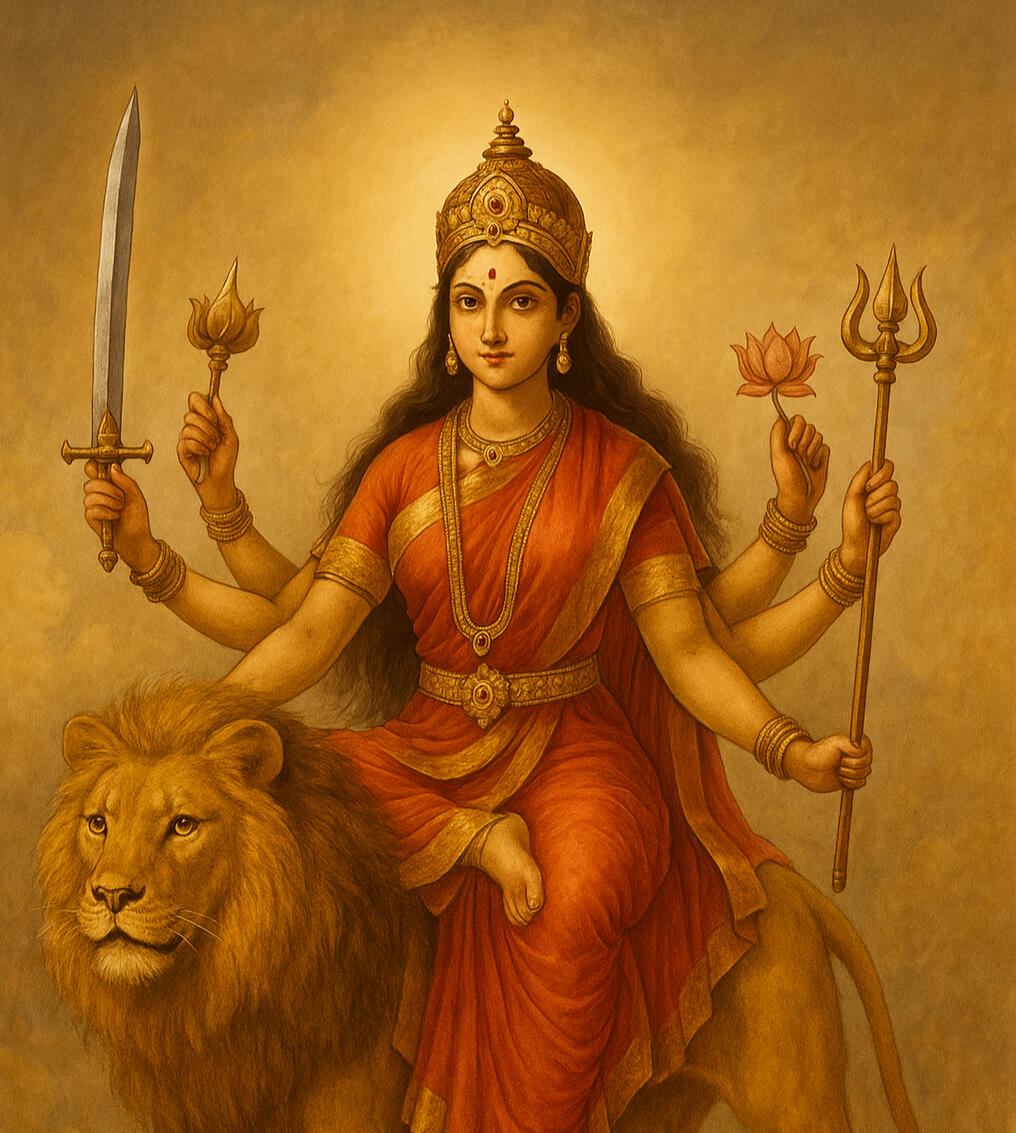
On the sixth day of Navratri, we honor Ma Katyayini, one of the fiercest and most powerful forms of Durga. According to legend, she was born to the sage Katyayan as the warrior goddess who would destroy the demon Mahishasura. She rides a lion and is often depicted with four, ten, or even eighteen hands, carrying weapons of divine power, a form that radiates courage, righteousness, and strength.Her iconography is striking: the lion beneath her symbolizes fearlessness, and her many arms represent the capacity to handle life’s endless battles. Yet her face remains calm and graceful, reminding us that true power is not rage but controlled strength.For me, Ma Katyayini represents that stage in a woman’s life when the demands of the world feel unrelenting. As a young mother and professional, I often felt as though I needed more than two hands. On one side, the expectations of being the “perfect wife” and loving mother; on the other, the ambitions of building a career and proving myself in a competitive world. Many days, I felt stretched so thin, I believed women must have been meant to be born with eighteen hands just to keep up.After motherhood, I had to restart my career from ground zero. By the time I was 21, I had already reached the pinnacle of leading as Head of South India for Learning & Development at one of the largest financial institutions in India. Yet, after moving to the US and becoming a mother, those achievements felt like a distant past, almost a different lifetime.When I returned to work, I began again — this time as a QA analyst. From having assistants to manage my emails and schedule, I now had to learn the technical skills to test computer applications for bugs. As a lifelong L&D professional, I had been wired to teach others how to do things perfectly, but in this new role, I didn’t even know enough to ensure the functionalities I tested were error-free. I failed miserably. Within a year, I was let go. For the first time, I felt like a failure in my career and in my life.I didn’t know where to turn. My heart longed to return to Learning & Development, but the world around me insisted that someone of my background was only valued in technology roles. And yet, I had just failed in technology. I felt defeated.But motherhood and Ma Katyayini both taught me a deeper truth. I watched my daughter, just seven months old, trying to walk. She would stumble, fall, get hurt, and then try again. Not with fear, but with persistence and even a smile. She became my first mentor, showing me what fearlessness looks like. If she could rise after every fall, so could I.I began again. I took courses, learned new tools, and slowly carved a path forward. I eventually landed a role as a SharePoint administrator, a job that gave me the courage to keep marching. Step by step, I rebuilt.And so, in this phase of my life, I saw Ma Katyayini not just in myself but in my daughter, reminding me that a warrior doesn’t stop after failure. She keeps walking, even when she stumbles. She rides her lion and claims her place, even when the world doubts her.Her teaching for me is to unlearn perfection. Perfection is an illusion that keeps us trapped. Katyayini shows us that strength is not in meeting every expectation, but in riding the lion of our truth — fierce, focused, and free.
Day 7 – Ma Kalaratri
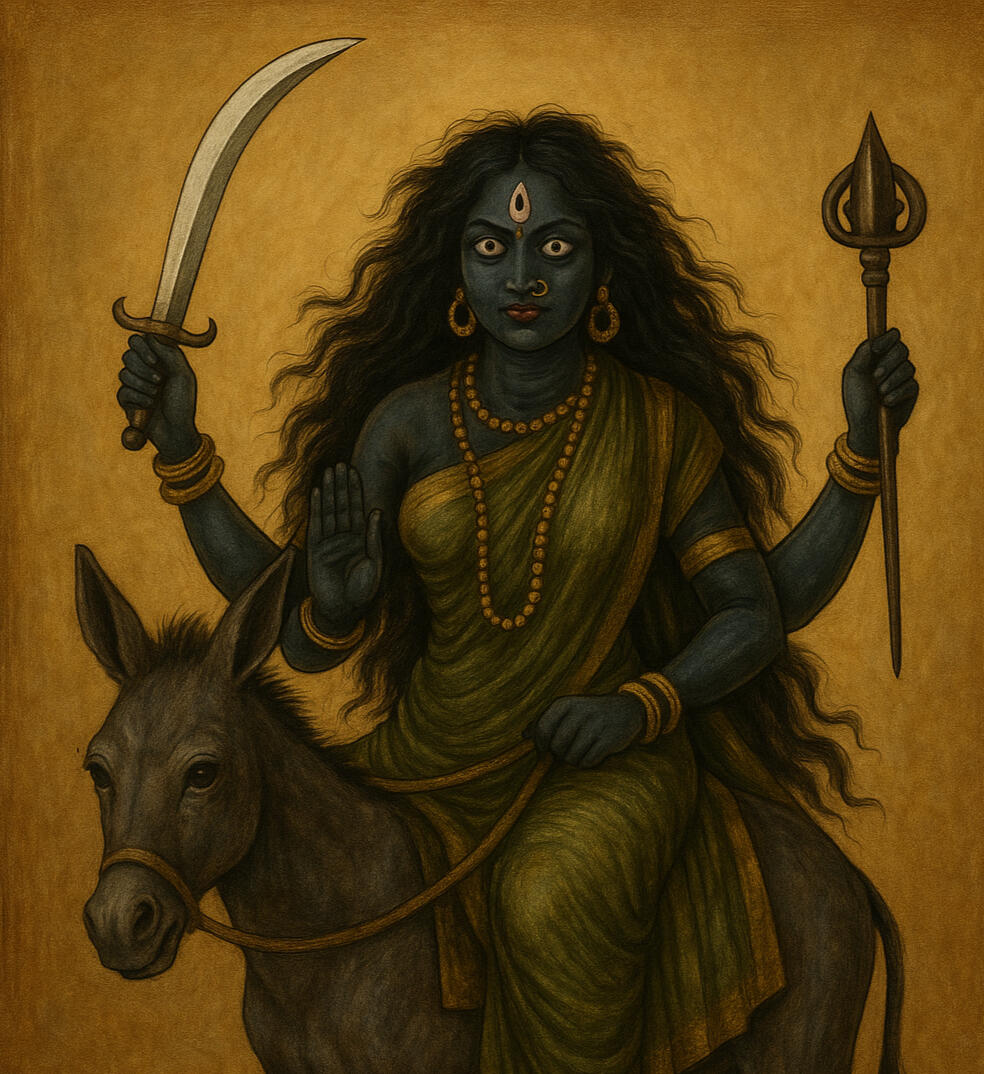
On the seventh day of Navratri, we honor Ma Kalaratri, the fiercest and most feared form of Durga. Her name means “the one who rules over time and night.” She is often depicted with dark skin, unkempt hair, a necklace of lightning, three eyes that radiate fire, and a fearless posture while riding a donkey. In her four hands, she carries a sword and a deadly iron hook, while the other two are raised in blessing and protection.Ma Kalaratri rides a donkey, not a lion or a majestic bull like all the other Devi's we read about before. To me, this reflects the essence of midlife itself, carrying burdens silently, navigating fears, and moving forward even when the journey feels heavy. The donkey reminds me that resilience isn’t always loud or celebrated; sometimes it’s simply the quiet persistence to put one foot in front of the other.While her appearance may seem terrifying, so is this midlife phase for many of us; like her essence, this phase is not a destruction for destruction’s sake; it is the destruction of ignorance, ego, and fear.Day 7 also marks the transition into the Sattva (transformation) phase of life. The midlife season when the questions of “Who am I?” and “Why am I here?” grow louder. It is often called the “midlife crisis,” but I see it as the Kalaratri phase. A time when we must confront our fears, our shadows, and the truths we’ve avoided.For me, Kalaratri reflects those moments when I’ve had to face myself in raw honesty. There have been times in my journey through health struggles, personal losses, and career resets, when the fears inside me were louder than any external challenge. Fear of failing again. Fear of being unseen. Fear of not being accepted by others. Fear of losing my place in the world I worked so hard to build.But like Kalaratri, I learned that running from fear only gives it more power. The only way through was to look it in the eye. My OPLL diagnosis, my surgery, and the years of managing pain taught me that the darkest nights often hold the greatest awakenings. They stripped away illusions and forced me to redefine who I am, not by what I achieve, but by what I endure and transform into.Her lesson is to unlearn fear itself. Fear of judgment. Fear of loss. Fear of losing friends you thought you would cherish for life, Fear of endings. Kalaratri shows us that fear is not a wall but a mirror, and when we face it, we discover that we are braver than we ever believed.Reflection for Today:
* What fear do you need to look in the eye today?
* How can you unlearn fear’s grip and transform it into strength?
* What part of your shadow self is waiting to teach you courage?Happy Navratri
Day 8: Ma Mahagauri
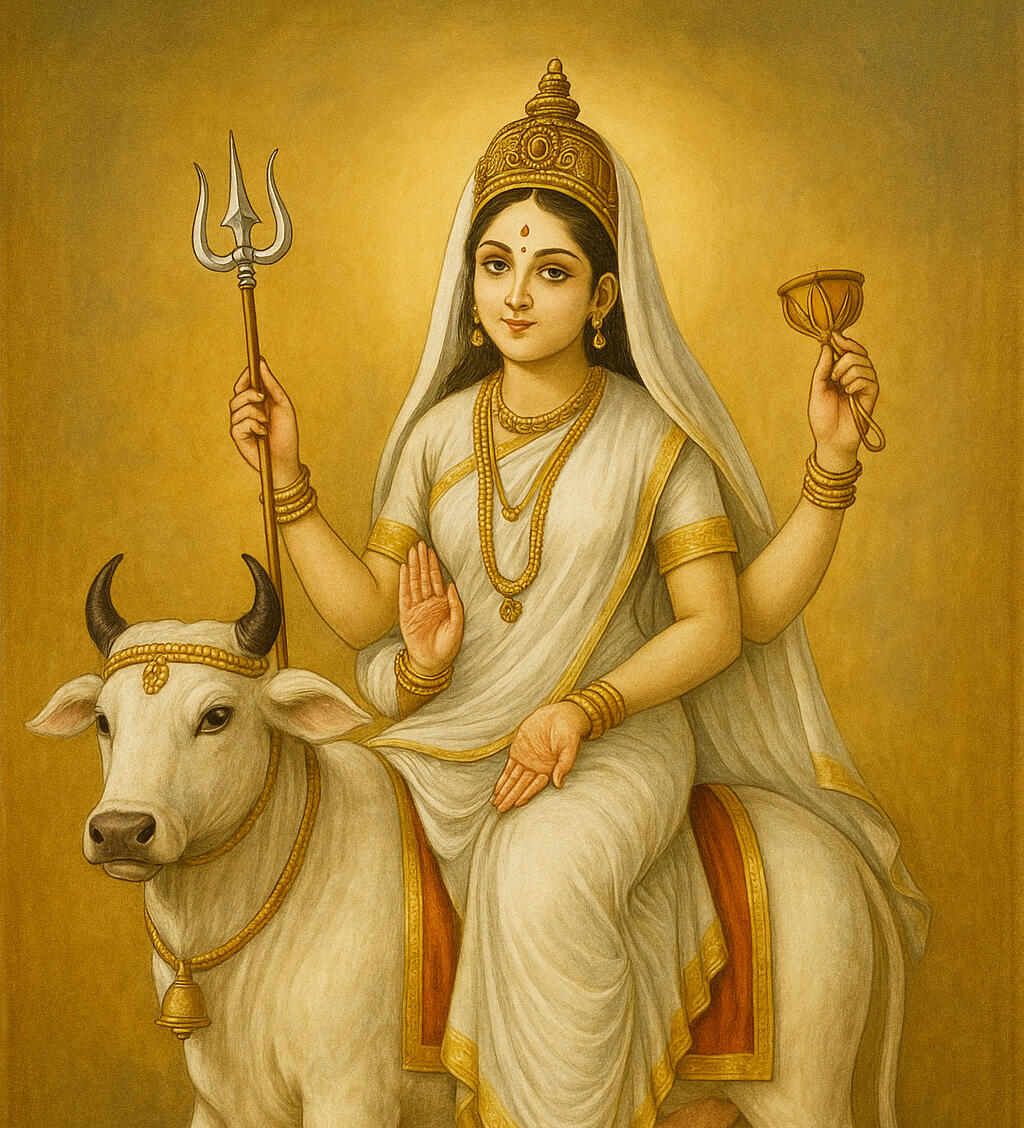
On the eighth day of Navratri, we honor Ma Mahagauri, the goddess of purity, serenity, and transformation. Her name means the Great White One, symbolizing radiance and clarity. She is often depicted riding a bull, dressed in pure white, with four hands, carrying a trident and a damaru in two, and the other two in blessing and protection.According to legend, Parvati undertook intense penance to win Shiva as her consort, enduring years of hardship. Her body darkened from the severity of her tapas, but when Shiva finally accepted her, he bathed her in the holy waters of the Ganga. Emerging from those waters, she was transformed into Mahagauri, glowing with unmatched beauty, grace, and purity.Day 8, also known as Durga Ashtami, represents the Sattva (refinement and transformation) phase of life. After the restless energy of youth and the burdens of adulthood, Mahagauri reflects the shift toward peace, wisdom, and spiritual awareness. This is the time when the pursuit of outer achievements softens, and the quest for inner harmony becomes central.For me, Mahagauri reflects the phase of my life where I began to understand that success is not defined by titles or roles but by clarity, peace, and alignment. In my earlier years, I chased perfection, recognition, and proof of worthiness. I longed for validation, being invited, included, accepted, and loved. But as life unfolded, through career resets, motherhood, health battles, lost friendships, and spiritual seeking, I realized that the most profound transformations come not from striving but from surrender.I also came to see how much of that striving was shaped by my childhood. My parents worked tirelessly to give my sister and me the best education they could afford, even when it was far beyond their means. My mother worked as a chef for a dancer in Bangalore; my father was a security guard. Money was scarce, but they put me in an English-medium school to give me opportunities they never had.On the surface, this was a gift. But as a child, it often felt like a curse. I entered that school under the “underprivileged” category, and every waiver, every concession, was announced to the class. My classmates pitied me; they didn’t befriend me. On days without uniforms, I wore stitched shoes or hand-me-down clothes, while others flaunted new outfits. I went from being a top student in middle school to nearly failing in high school, weighed down by shame and isolation. All I dreamed of was escaping into a future where I could earn so much money that no one would ever know my past.I carried those insecurities with me into adulthood, seeking acceptance, doing anything for others so they wouldn’t pity me, confusing being “needed” with being “loved.” It took me years and deep spiritual work to recognize these patterns and consciously release them. Mahagauri’s white radiance reminds me that purification is not about being flawless; it is about shedding the layers of insecurity, fear, and attachment until only truth remains.Even her bull speaks to me. The bull is not graceful like a horse or majestic like a lion. It is steady, enduring, and patient — carrying burdens without complaint. To me, the bull symbolizes the weight of survival and responsibility I carried through my youth and into adulthood. Like the bull, I learned to endure silently, to push forward no matter how heavy the load. Mahagauri riding the bull reminds me that endurance, too, can be sacred when paired with serenity; it transforms into grace.Her teaching for me is to unlearn attachment. Attachment to recognition, to roles, to identities, or to the illusion of perfection can cloud our peace. Mahagauri shows us that when we release, we become light again.* Reflection for Today:*
* What attachments are holding you back from peace?
* What would it look like to unlearn the chase for recognition and choose clarity instead?
* How can you invite more serenity into your life today?Happy Durga Ashtami!
Day 9 – Ma Siddhidatri
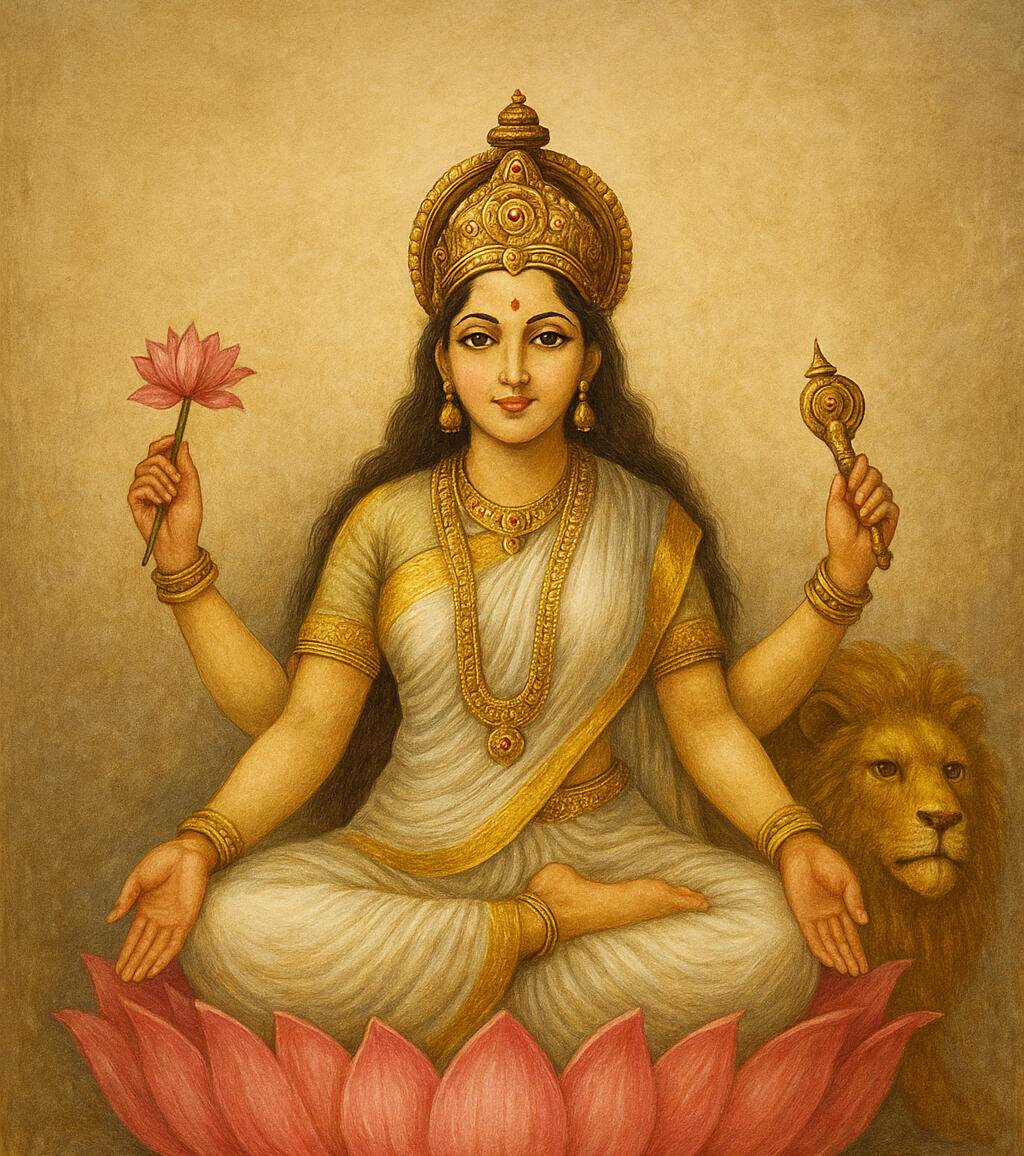
On the ninth day of Navratri, we honor Ma Siddhidatri, the goddess of perfection, balance, and divine completeness. Her very name means the giver of siddhis (the spiritual powers that dissolve illusion and bring wholeness). She is depicted seated on a lotus, serene and radiant, with four hands holding a conch, discus, mace, and lotus. She embodies harmony where the dualities of masculine and feminine, effort and surrender, striving and stillness dissolve into one.Even Shiva (the god of transformation) himself is said to have received blessings from Ma Siddhidatri in becoming Ardhanarishvara (half man - half woman) symbolizing the truth that completeness is not found in halves but in union.For me, Ma Siddhidatri reflects the final phase of life’s journey: a state beyond striving, beyond the chase for recognition, beyond even the cycle of fear and attachment. It is the state of resting in what is, rather than grasping at what could be. It is the state where gratitude becomes the breath, and simply being is enough.I am not yet fully there, but I know I am walking toward it. My life has carried many burdens - childhood struggles, longing for acceptance, chasing perfection, career resets, motherhood, and above all, health battles that nearly claimed my life twice.The first time was during my C-section hysterectomy, when I nearly lost my life on the table. The second was years later, when OPLL forced me into a spinal fusion from T2 through L2 neck to shoulder, metal rods fused into my body, leaving me with less than half my mobility. Both times, I emerged broken yet alive, carrying scars that were not only physical but deeply spiritual.For years, I carried those scars like weights, just as I carried the baggage of my childhood and the wounds of adulthood. But slowly, through pain and persistence, I began to see what Siddhidatri embodies: that wholeness is not about erasing the scars but about embracing them. That bliss is not about escaping life but about living fully awake within it.Her lotus reminds me of how many times I have risen from muddy waters. Her discus reminds me of the cycles I’ve broken through unlearning. Her conch reminds me of the voice I found - my own, and the voices I now help others discover. Her mace reminds me that my survival, twice tested, has forged a strength I never knew I had.Ma Siddhidatri teaches me to unlearn incompleteness. For so long, I thought I wasn’t enough, not accomplished enough, not accepted enough, not whole enough. But today, I understand that every scar, every story, every survival has always been preparing me for purpose. My purpose now is clear: to help others bring their stories to life, to help them unlearn what binds them, and to remind them that the entire universe resides within their own being.I am not fully at her stage of bliss yet. I still feel, I still want, I still get tangled in the world’s demands. But I am aware, and I am consciously unlearning. And with each step, I move closer to that quiet place where, like Siddhidatri, I can simply be.Reflection for Today:
• Where in your life do you still feel incomplete?
• How can you begin to unlearn that illusion?
• What would it look like to live from the wholeness that’s already within you?Happy Navratri!
The Shree Yantra - Where Spirituality Meets Science
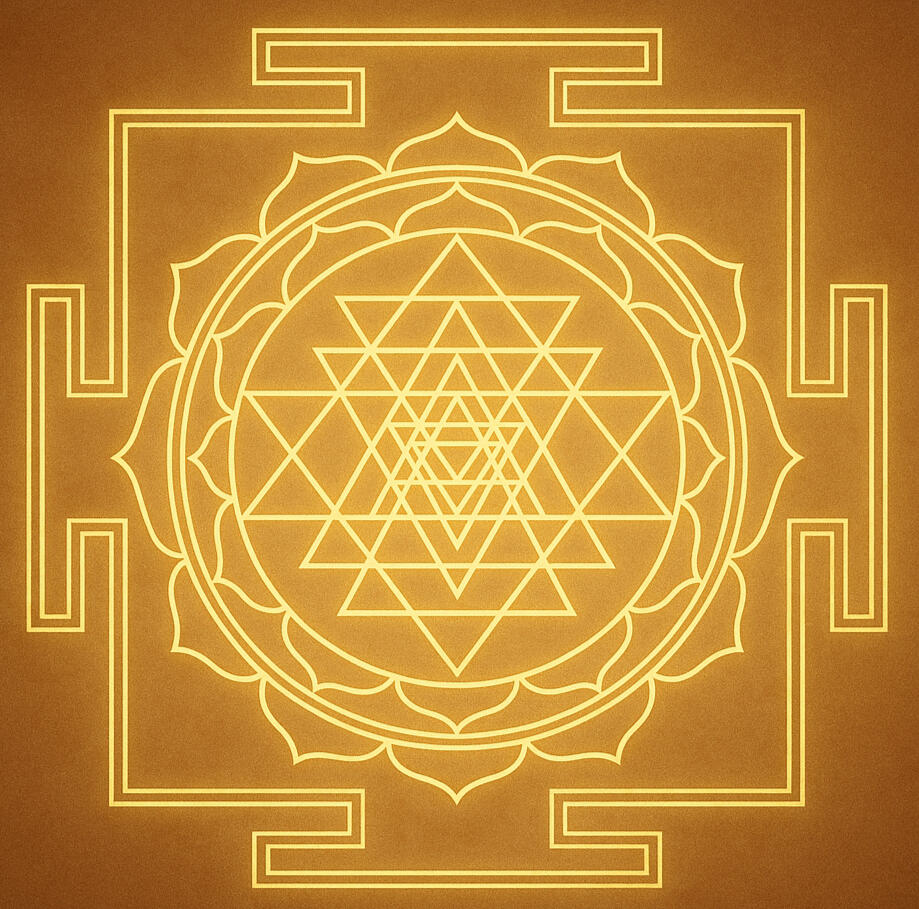
When I first looked at the Shree Yantra as a kid, I saw only triangles. It looked pretty and mysterious but, also confusing. But, only in the recent years when I learned more about the significance of geometry, patterns and space, I realized, this yantra isn't just an art of bunch of traingles. It is a map of our cosmos.The Shree Yanta is made of interlocking triangles, circles, and lotus petals, each one symbolizing something very significant. Modern science now studies these same patterns as fractals and sacred geometry, finding the same patterns everywhere from the spirals of galaxies to the structure of DNA.For me, the Shree Yantra is more than a diagram. It's a reminder that life itself is a pattern, sometimes chaotic, but always with a hidden order. When I went through various setback and painful transitions in my life from surgeries to lost friendships to rebulding myself multiple time again and again, I often felt broken. But the yantra reminds me, even broken lines form part of a perfect whole.This is where spirituality meets science. The yantra tells us:
* We are not separate from the universe.
* All our stories, like the traingles, overlap and interconnect with each other.
* Balance is not found outside, but within the patters of our own life.If the Yantra teaches me anything, it is the power to unlearn chaos and see the geometry of grace in my journey.Ref: Gaia - Sacred Geometry, Spiritual science with Robert J. Gilbert.
Happy Dussehra - A full Circle
Today we celebrate Dussehra, the victory of good over evil. The story is often told through the triumph of Rama over Ravana, but for me, this day has always carried a deeper, more personal meaning.Dussehra is the day I was born. And every year, as it arrives at the close of Navratri, I feel as though I have come full circle. Navratri takes us through the many forms of Devi — her innocence, her discipline, her courage, her motherhood, her fearlessness, her serenity, her wholeness. And then comes Dussehra, reminding us that after all the journeys, all the struggles, all the battles — what ultimately matters is the triumph of good over evil.But evil is not always some grand, external villain. More often, it is subtle. It hides in jealousy, in insecurity, in comparison. It is present when we cannot cheer for one another wholeheartedly, when we place conditions on our love, when we carry the heavy burdens of our own nature and nurture. Evil is the whisper in our minds that tells us we are not enough, that others are threats, that love must be earned.The real battle of Dussehra is not fought on a battlefield, it is fought within. With every breath, we choose: Do we react with kindness or resentment? With generosity or fear? With love or with judgment? This battle is not easy, and it cannot always be won in a single conscious pause. Sometimes evil does take over, we slip, we falter, we react in ways we wish we hadn’t.But the true victory lies not in never falling, but in becoming aware, in course-correcting, in returning to the path of good. And in supporting each other as we walk it together. After all, we are all connected through our universal consciousness, through the invisible threads that weave us into one.For me, being born on Dussehra feels like a divine reminder that my life’s journey is meant to be about these very battles. From the struggles of my childhood, to the health battles that nearly ended my life, to the unlearning of perfection, acceptance, and attachment, my path has always been about transforming the inner Ravana (darkness) into light. About finding my voice, and helping others find theirs. About choosing, again and again, to rise with love.And so today, as I celebrate my birthday on Dussehra, I honor this full cycle. The battles I’ve fought. The lessons I’ve learned. The unlearning that continues. I honor the Devi in me and in every one of us who strives each day to let the good within shine brighter than the shadows.May this Dussehra remind us all that victory is not once and done. It is daily, conscious, sacred work. May we choose goodness not only for ourselves, but for each other. May we rise together, connected, as one.Happy Dussehra!
And to me, happy birthday - a celebration of life, rebirth, and the ongoing journey of light.